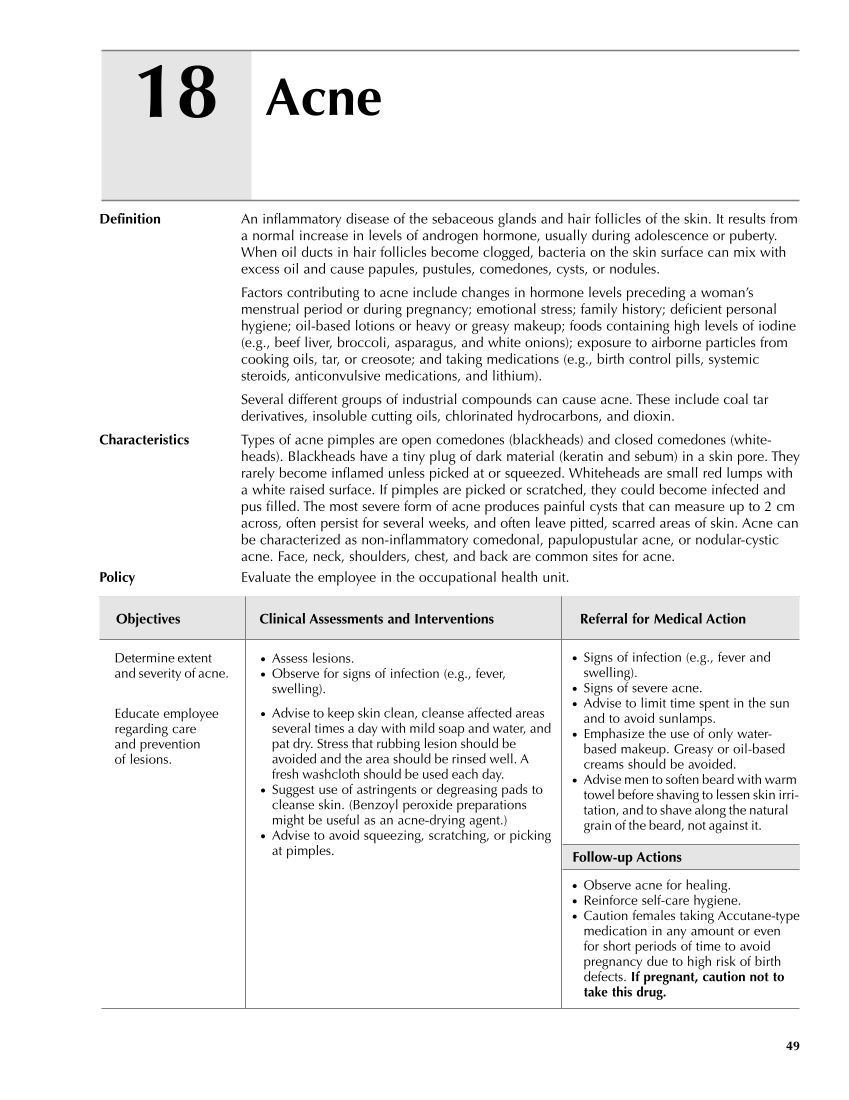Definition An inflammatory disease of the sebaceous glands and hair follicles of the skin. It results from a normal increase in levels of androgen hormone, usually during adolescence or puberty. When oil ducts in hair follicles become clogged, bacteria on the skin surface can mix with excess oil and cause papules, pustules, comedones, cysts, or nodules. Factors contributing to acne include changes in hormone levels preceding a woman’s menstrual period or during pregnancy emotional stress family history deficient personal hygiene oil-based lotions or heavy or greasy makeup foods containing high levels of iodine (e.g., beef liver, broccoli, asparagus, and white onions) exposure to airborne particles from cooking oils, tar, or creosote and taking medications (e.g., birth control pills, systemic steroids, anticonvulsive medications, and lithium). Several different groups of industrial compounds can cause acne. These include coal tar derivatives, insoluble cutting oils, chlorinated hydrocarbons, and dioxin. Characteristics Types of acne pimples are open comedones (blackheads) and closed comedones (white- heads). Blackheads have a tiny plug of dark material (keratin and sebum) in a skin pore. They rarely become inflamed unless picked at or squeezed. Whiteheads are small red lumps with a white raised surface. If pimples are picked or scratched, they could become infected and pus filled. The most severe form of acne produces painful cysts that can measure up to 2 cm across, often persist for several weeks, and often leave pitted, scarred areas of skin. Acne can be characterized as non-inflammatory comedonal, papulopustular acne, or nodular-cystic acne. Face, neck, shoulders, chest, and back are common sites for acne. Policy Evaluate the employee in the occupational health unit. Objectives Clinical Assessments and Interventions Referral for Medical Action 49 Acne 18 ● Signs of infection (e.g., fever and swelling). ● Signs of severe acne. ● Advise to limit time spent in the sun and to avoid sunlamps. ● Emphasize the use of only water- based makeup. Greasy or oil-based creams should be avoided. ● Advise men to soften beard with warm towel before shaving to lessen skin irri- tation, and to shave along the natural grain of the beard, not against it. Follow-up Actions ● Observe acne for healing. ● Reinforce self-care hygiene. ● Caution females taking Accutane-type medication in any amount or even for short periods of time to avoid pregnancy due to high risk of birth defects. If pregnant, caution not to take this drug. Determine extent and severity of acne. Educate employee regarding care and prevention of lesions. ● Assess lesions. ● Observe for signs of infection (e.g., fever, swelling). ● Advise to keep skin clean, cleanse affected areas several times a day with mild soap and water, and pat dry. Stress that rubbing lesion should be avoided and the area should be rinsed well. A fresh washcloth should be used each day. ● Suggest use of astringents or degreasing pads to cleanse skin. (Benzoyl peroxide preparations might be useful as an acne-drying agent.) ● Advise to avoid squeezing, scratching, or picking at pimples. Guideline continues on next page
Purchased from OEM Press by (ge corporate access). (C) 2013 OEM Health Information, Inc. All rights reserved.












































































































































































































































































































































































































































